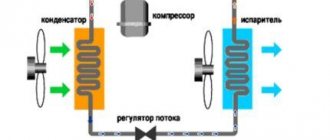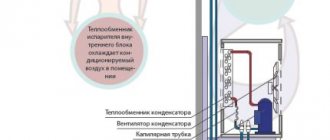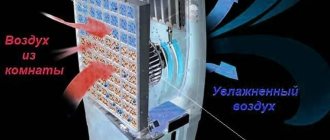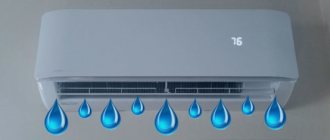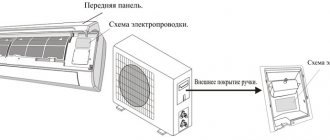Owners of air conditioners do not often pay attention to the external unit - as a rule, it hangs outside the window. But sometimes, especially if the split system begins to malfunction, a full inspection begins. You looked at the outdoor unit and noticed frost, snow or ice on it or the pipes coming out of the unit. What are the causes of freezing and what to do in such a situation, we will talk in this article.
The following elements of the outdoor unit can freeze:
- A thick tube (and a tap on it). The thick tube is also referred to by specialists as a “suction”, “gas” or “low pressure” tube.
- A thin tube of the block (and a tap on it). Its masters are also often called "liquid", "pressure" or "high pressure" tube.
- Both tubes – thick and thin. Sometimes the external unit itself freezes over.
If you see ice on any elements of the external unit, do not rush to get upset: in some cases this is a normal situation:
When freezing of the pipes of the outdoor unit of the air conditioner is not a breakdown
- Turning on the air conditioner for the first time after winter. Pipes often freeze when the split system is started for the first time after a long period of inactivity. Let the air conditioner run for an hour or two. Perhaps the tubes will thaw and will no longer freeze.
- A light layer of frost on the pipes. Let’s assume that the split system is working properly in all modes and there is no “fur coat” in the outdoor unit. A small layer of frost turns into weak condensation on the pipes during the “rest” of the air conditioner.
If you see a lot of ice in the external unit, or the presence of frost on the pipes is combined with poor cooling of the air conditioner, most likely it is a breakdown.
Freon shortage
Another possible reason why the air conditioner evaporator freezes is a lack of refrigerant. Freon performs the main role - it takes heat from the room and transfers it to the street. If there is not enough of it, it will not be able to effectively cool the room.
Determining a lack of refrigerant is simple: inspect the service valves on the outdoor unit. They are usually located on the side wall at the bottom right. In some models, the valves are protected from precipitation by a plastic or metal cover. If there is frost on the service valve, there is not enough refrigerant in the system.
There are two reasons for a lack of refrigerant:
- There is a leak in the system;
- After service, little freon was added;
- The permissible length of the freon line has been exceeded.
Reasons why a thick air conditioner pipe freezes
The appearance of ice on the thick tube of the external unit of the air conditioner and its nut is due to the fact that the cooling process continues after the internal unit. This happens because the refrigerant does not completely boil off in the evaporator. “Boiling over” occurs in the suction tube of the compressor, which is why it freezes.
Quite often, the reason lies not in a breakdown, but in incorrect installation, incorrect maintenance or unprofessional repair of the air conditioner. The most common installation, maintenance and repair errors that cause freezing of the gas pipe include:
- Excess refrigerant . If, during installation or refilling, too much freon is poured into the split system, it will boil not only in the evaporator, but also in the thick tube.
- Short route . Each air conditioner manufacturer specifies in the instructions the permissible length of the route. If it was shortened during installation, this will also lead to freezing of the low pressure pipe.
- Kink of a thick tube . Sometimes during “makeshift” installation of air conditioners, the pipe is bent. This leads to disruption of the circulation of freon, as a result, it partially boils in the gas tube, and you see ice on it.
If the air conditioner worked normally before, it was not refilled, and ice begins to appear on the thick tube - a breakdown has occurred. The table below will help you independently determine what exactly is faulty in your split system and estimate the cost of repairs.
Contamination of the internal unit of a split system - from 1900 rubles.
Due to accumulated dust and dirt, heat transfer is reduced, which leads to incorrect operation of the air conditioner.
Signs
The thick tube on the external unit is frozen. At the same time, the air conditioner does not cool well, and ice may form in the indoor unit. When ice melts, water may drip from the indoor unit.
How to fix
It is necessary to carry out a comprehensive cleaning of the air conditioner.
The technician removes dirt from the coarse and fine filters, evaporator and indoor unit fan.
Contamination of the external unit - from 2200 rubles.
A large amount of dirt and dust impairs the heat exchange of the outdoor unit with the environment and leads to improper operation of the split system.
Signs
The air conditioner does not cool well. The external unit is clogged with dirt and dust, the thick tube is completely covered with a snow coat.
How to fix
The external unit needs to be cleaned and dirt, dust and small debris removed.
Malfunction of the indoor unit fan - from 1,700 rubles.
Signs
The air conditioner does not blow well and does not cool well.
At the same time, the suction tube on the external unit is covered with a thick layer of frost. The indoor unit may also freeze and leak into the room.
How to fix
A failed part must be repaired or replaced depending on the type of failure.
The TRV/ERV valve is faulty or its settings have gone wrong (for complex split systems) - from RUB 1,900.
The expansion valve or electronic expansion valve does not create enough pressure drop to boil off the refrigerant in the evaporator. As a result, the freon “boils” in the gas pipe, which leads to its freezing.
Signs
The split system does not cool well, and the thick pipe on the external unit freezes.
How to fix
The expansion valve needs to be adjusted or replaced.
Note! EEVs and expansion valves regulate the refrigerant pressure depending on changes in ambient temperature. Basically, they are installed in complex split systems. In simple air conditioners, they are usually replaced by a capillary tube, “tuned” to a constant pressure drop.
Not enough air
Insufficient air flow is one of the common reasons for the formation of frost and ice inside the wall unit of a split system. In addition to internal reasons, there are external ones. Namely, the wrong choice of installation location.
In any operating mode, the air conditioner draws air in at the top and blows it out at the bottom. To avoid obstacles, it is not recommended to hang the indoor unit close to the ceiling. There should also be no obstructions to the outgoing flow.
You will find the permissible distances in the documentation for your model. But experts recommend taking into account the power of the air conditioner and the height of the room’s ceilings. Below is the minimum distance from the ceiling to the indoor unit:
| Ceiling height | up to 12 thousand BTU | 12-18 thousand BTU | 18-30 thousand BTU |
| up to 2.7 meters | 7 cm | 10 cm | 15 cm |
| 2.7-3.0 meters | 10 cm | 15 cm | 20 cm |
| 3.0-3.7 meters | 15 cm | 15 cm | 20 cm |
| 3.7+ meters | 30 cm | 30 cm | 30 cm |
Using a screen for an air conditioner also creates problems for the distribution of cooled air. With a screen, the indoor unit should be located 5 cm lower than without it.
Reasons why a thin air conditioner pipe freezes
Ice or a “fur coat” on the thin tube (and its nut) of the external unit of the split system indicates that the cooling process begins even before the internal unit. This is due to the fact that freon begins to boil before entering the evaporator.
Freezing may occur if your air conditioner is installed, serviced, or repaired by unqualified personnel. Here are the “handicraft” mistakes that RemBytTech craftsmen most often encounter:
- Moisture in the cooling circuit. This could happen if unprofessional repairs were carried out to eliminate a leak or refill the air conditioner with refrigerant.
- The route is too long. Longer than provided by the split system manufacturer.
- Partial shut-off of the tap-valve on a thin tube. This leads to it boiling before the evaporator and freezing of the liquid tube.
If the air conditioner has not been touched, it was working properly before, but the high-pressure pipe freezes over, most likely some kind of breakdown has occurred. The most common ones are the following.
Clogged capillary pipeline - from RUB 3,900. (sealing and charging of the system included)
Due to contamination of the capillary, a large pressure drop occurs at the inlet and outlet of it. It leads to early boiling of freon and cooling, even before the refrigerant enters the evaporator.
Signs
A thin tube in the ice.
The compressor hardly turns off, and the air conditioner does not cool well. Sometimes there may be a leak from the indoor unit into the apartment.
How to fix
To clear the blockage, high-pressure compressed nitrogen is used. If there is no result, hydraulic cleaning with solvents is used.
In particularly difficult cases, when it is not possible to remove the “plug,” the capillary tube is completely replaced with a new one.
Lack of refrigerant - from 2300 rubles.
Freon leakage can occur either due to depressurization of the circuit or as a result of long-term operation (up to 7% of the refrigerant can escape from air conditioners every year).
Signs
A thin air conditioner tube covered in frost.
At the same time, the split system cools poorly; water may drip from the indoor unit or “fly out” along with a stream of air. Ice is visible on the evaporator If the air conditioner is equipped with an electronic display, the “low pressure” error is displayed
How to fix
It is necessary to check the tightness of the system; if there is a leak, fix it.
After this, the technician seals the system and charges the air conditioner with freon.
The thermostatic or electronic valve has failed or its settings have gone wrong (for complex split systems) - from RUB 1,900.
The expansion valve / expansion valve creates an excess pressure drop, which is why the refrigerant begins to boil before the evaporator in the indoor unit. This leads to freezing of the high pressure pipe.
Note! An electric valve or expansion valve regulates the refrigerant pressure depending on changes in ambient temperature. The only difference between the valves is that in the electric valve the adjustment is electronic, while in the expansion valve it is mechanical. Basically, they are installed in complex split systems. In simple air conditioners, they are usually replaced by a capillary tube, “tuned” to a constant pressure drop.
Signs
Freezing of the high pressure pipe.
How to fix
The valve needs to be adjusted or replaced.
Freon line length
Each air conditioner has a refrigerant charge rate based on weight. But it depends not only on the model. The length of the freon line plays a big role. As a rule, 5 meters of copper pipes are supplied with the split system. If the distance between the blocks is greater, you will have to increase them.
The longer the freon pipeline between the blocks, the greater its volume. If air conditioners with different line lengths are filled with the same amount of gas, the pressure in the system will be different. Amateur air conditioners do not know about this or forget.
If ice forms on the indoor unit of the air conditioner after installation, the reason may be a lack of refrigerant. You won't be able to determine this on your own. Testing for freon deficiency requires special equipment and skills.
Reasons why both tubes on the external unit of the air conditioner freeze
If your air conditioner operates on “heat”, then freezing of the pipes of the outdoor unit is normal. During the rest cycle, the tubes will thaw. Then the freezing regime will repeat.
The only thing that is important to remember is that you can use the air conditioner, both for heating and cooling, only when the outside temperature is not lower than permissible for your model. It is precisely ignoring this rule that very often leads to freezing of both tubes, nuts and the entire external unit. In particular, this happens when:
- The air conditioner operates for cooling at low outside temperatures.
- The air conditioner operates “warmly” at low outside temperatures.
Note! The operating temperature ranges of the split system depend on the brand and device. For example, inverter models can be operated at lower temperatures (down to -10 - -15°C) than conventional ones. To find out the permissible outside temperature limits for your air conditioner, refer to the operating instructions or technical data sheet of the equipment. Please note that for cooling and heating modes, these ranges will be different for the same air conditioner.
Note! If year-round operation of the split system is required, the air conditioners are equipped with a “winter kit”. It consists of a sensor that reduces the rotation speed of the external fan at low temperatures (this reduces the formation of ice in the outdoor unit), as well as heating systems for the compressor and drainage. Together they help prevent the oil from thickening and also warm up the drainage system. With the winter kit, the use of the split system is possible down to -25 – -30°C outdoors. You can order the winter kit installation service from our service center.
If you have followed all the operating rules, and the external unit is covered with ice, the reason is some kind of breakdown.
The heat exchanger sensor of the outdoor unit is faulty - from 2000 rubles.
The sensor should normally give a command to turn on the defrost mode. If this does not happen, the block becomes covered with ice.
Signs
Both tubes and nuts of the external unit freeze when the air conditioner is running on “heat”, while the split system heats poorly.
How to fix
A failed sensor must be replaced with a working one.
Control board malfunction - from RUB 3,500.
The air conditioner does not give the defrost module a command to start working. As a result, the external block freezes.
Signs
Both tubes and nuts of the external unit freeze when the air conditioner is running on “heat”, while the split system heats poorly.
How to fix
The control board needs to be repaired or replaced.
The external unit is dirty - from RUB 2,200.
Because of this, heat exchange deteriorates and the air conditioner does not work correctly.
Signs
When operating on “heat”, the outdoor unit freezes, and the heating is weak. Dirt and dust are visible on the external unit.
How to fix
The outdoor unit needs cleaning.
Lack of freon in the system due to a leak or prolonged lack of maintenance of the air conditioner - from 2300 rubles.
According to experts, up to 7% of the refrigerant can escape from a split system every year.
Signs
When working on “heat”, the external unit freezes, the air conditioner does not heat well.
How to fix
The cause of the leak must be determined. If the circuit is depressurized, the leak will first need to be eliminated. Next, the system is evacuated and charged with a suitable refrigerant according to the instructions on the scale.
Faulty 4-way valve - from RUB 3,500.
This unit is responsible for switching between heat and cold modes. To defrost the outdoor unit, the cooling mode is turned on. During this, the heat exchanger of the external block thaws, and the fan of the internal block is turned off so as not to drive cold air into an already heated room. Sometimes the valve “sticks” due to heat, in which case the defrost of the external unit cannot turn on. As a result, the external unit becomes covered in ice, heat exchange deteriorates, and the split system does not heat the room well.
Signs
When working on “heat”, the external unit freezes, the air conditioner does not heat well.
Wrong selection
Ice in the indoor unit of the air conditioner is formed due to the low temperature of the gas in the evaporator. One of the reasons is incorrect selection of cooling capacity. When choosing a model you need to consider:
- Volume of the refrigerated room;
- Indoor temperature;
- Temperature outside the room;
- Heat influx from other sources.
If the air conditioner is chosen incorrectly, it will not have time to cool the room. Because of this, it will work more intensely and turn on more often. The refrigerant is greatly supercooled. Accordingly, moisture from the surrounding air condenses and freezes on the evaporator. This most often happens with non-inverter systems.
To check if your system has enough cooling capacity, use an online air conditioner capacity calculator. Compare the obtained values with the parameters of your model.
The documentation for the air conditioner or the nameplate on the indoor or outdoor unit (see photo) may indicate the capacity in kW or BTU (British Thermal Units). It is necessarily present in the model name. For example, the Daikin FTXB20C model has a cooling capacity of 2.0 kW. And Neoclima Alaska 2.0 NS-09AHTIw – 9000 BTU.
This is how the power of the air conditioner is shown in BTU on the nameplate of the indoor or outdoor unit.
To convert kilowatts to BTU, multiply the value by 3412. To convert BTU to kW, divide it by 3412. Or use this table:
| kW | BTU | BTU | kW |
| 1 | 3412 | 5000 | 1,47 |
| 1,25 | 4265 | 6000 | 1,76 |
| 1,5 | 5118 | 7000 | 2,05 |
| 1,75 | 5971 | 8000 | 2,34 |
| 2 | 6824 | 9000 | 2,64 |
| 2,25 | 7677 | 10000 | 2,93 |
| 2,5 | 8530 | 11000 | 3,22 |
| 2,75 | 9383 | 12000 | 3,52 |
| 3 | 10236 | 13000 | 3,81 |
| 3,25 | 11089 | 14000 | 4,10 |
| 3,5 | 11942 | 15000 | 4,40 |
| 3,75 | 12795 | 16000 | 4,69 |
| 4 | 13648 | 17000 | 4,98 |
| 4,25 | 14501 | 18000 | 5,28 |
| 4,5 | 15354 | 19000 | 5,57 |
| 4,75 | 16207 | 20000 | 5,86 |
| 5 | 17060 | 21000 | 6,15 |
| 5,25 | 17913 | 22000 | 6,45 |
| 5,5 | 18766 | 23000 | 6,74 |
| 5,75 | 19619 | 24000 | 7,03 |
| 6 | 20472 | 25000 | 7,33 |
If the installed air conditioner is weaker than necessary, there are three options:
- Set the temperature to a higher temperature;
- Install additional air conditioning;
- Replace the existing one with a more powerful one.
Store food correctly
Ready meals in open containers are a source of moisture and heat. Because of them, snow and ice form on the wall of the refrigerator. The icing principle is as follows:
- Moisture evaporates from the surface of warm foods;
- It condenses in the form of droplets on the back wall of the chamber;
- To cool warm food faster, the refrigerator compressor starts working faster;
- The evaporator and rear wall are cooled below 0 °C;
- Drops of water turn into snow and ice.
To avoid the formation of snow and ice in the refrigerator compartment, follow two simple rules:
- Do not put hot food in the refrigerator;
- Use closed dishes or containers to store food and prepared meals.
Storing heated foods can have harmful consequences. We wrote a separate useful article about this. We recommend reading it: “Why you can’t put hot food in the refrigerator.”
Service Masters
Send new questions to .
Panasonic split system: when turned on, it immediately turns off and the yellow LED starts blinking
2019-06-04 17:02
Panasonic nine split system: when turned on, it immediately turns off and the yellow LED starts blinking. What to do?
Flashing yellow LED may indicate three types of malfunctions:
- Refrigerant leak.
- The sensors (thermistors) of the indoor unit are faulty.
- The Hall sensor of the indoor unit motor is faulty.
Each of the three options has its own LED blinking algorithm.
Clogged filter drier
The filter drier is located between the condenser and the capillary tube. Its task is to draw moisture from the refrigerant and absorb it. It also traps impurities contained in the refrigerant and oil.
A clogged filter drier reduces the system's capacity. Because of this, freon circulates through it more intensively. The evaporator temperature drops and it becomes covered with ice. It is impossible to determine that the filter is clogged without dismantling it.
Important
Whenever working on the freon line, you need to check the condition of the filter drier. If you are refilling, replacing refrigerant or oil, you must change the filter.
Problems after repair diagnostics, prevention
If the inside of the refrigerator is covered with ice, remember whether the following work has been done:
- Diagnostics;
- Prevention;
- Freon refill;
- Repair.
An incompetent technician could disrupt the work settings or mechanically damage important components. 99% of problems with refrigeration equipment after service work are associated with errors by the refrigeration technicians. In this case, contact the company or individual who worked on your refrigerator.
Check the fan
If the air conditioner heats poorly but blows well, look at the outdoor unit. The fan may not be spinning. If this is the case, there are three reasons:
- The bearing has failed;
- The motor broke down;
- The pulley is clogged or iced up.
To check the options, remove the cover of the outdoor unit. Try turning the fan by hand. If it turns with difficulty, check the place where it connects to the pulley. Clear it of ice and dirt. Turn on the air conditioner and see if the problem is resolved.
If you hear extraneous sounds when the fan rotates (crackling, clicking, creaking), the problem is in the bearing. It needs to be replaced, it cannot be repaired. You can do this yourself by purchasing the appropriate one.
If the fan can be easily turned by hand, there is a problem with the motor. There are three options:
- The motor is broken;
- The wiring supplying power to it is damaged;
- Damage to the board supplying power to the motor.
Using an indicator screwdriver, check the power at the contacts of the connector through which the wiring to the motor is connected. If it is not there, the problem is in the board. You cannot repair it yourself (without the appropriate knowledge), look for a specialist.
If there is power from the board, check the voltage at the motor contacts. If it is not there, the problem is in the wires, they are broken or burned out. Select the appropriate cross-section and replace them. At the same time, pay maximum attention to tightness, because they are exposed to moisture.
If there is voltage at the contacts connected to the motor, it means it has failed. There is no point in repairing it, it is better to replace it. It’s not difficult to do this yourself if you purchase the appropriate one.
Lifehack
There is a possibility that the connector contacts have oxidized. You can try cleaning them with ethyl or ammonia. There are also special liquids and aerosols for cleaning contacts. They can be bought at auto stores.
Poor vacuum
When installing a split system, replacing the refrigerant and other operations with the freon line, it is necessary to evacuate it. This is necessary to remove air from the system into which freon will be pumped. If the line is not evacuated, air and moisture remain in it. This leads to a decrease in cooling capacity.
Refrigerant mixed with air is less able to remove heat from the room and releases it through the condenser. The compressor has to work more intensely, the temperature in the evaporator drops and ice appears on it.
The moisture contained in the air crystallizes into ice during operation. It settles on the walls of the system and reduces their cross-section. Ice flakes also damage connections and compressor parts. This leads to microcracks and shortens the service life of the air conditioner.
Weak air flow
One possible reason ice forms may be due to too little air flow through the evaporator coils. An air conditioner uses a very cold substance (refrigerant) to absorb heat and moisture from the air in your home. Heat exchange occurs in the evaporator coils (the part that is frozen). As warm air passes over these cold refrigerant coils, they absorb enough heat to prevent them from freezing.
But if there isn't enough warm air passing through the evaporator, the refrigerant-filled heat exchangers will malfunction, releasing moisture.
And the accumulated moisture will settle on the freezing coils, so the block freezes. Some of the factors that cause poor airflow are things you can fix yourself.
- Dirty, clogged air filters. The air filter needs to be checked and replaced.
- Return openings are blocked. Make sure that no curtains or furniture are blocking the openings. Keep items at least 60cm away from return vents to ensure proper airflow.
- Covered ventilation openings. Keep all vents open, even those in rooms or unused areas.
Article on the topic: Where is the air conditioner in Lanos
In other cases, you may need a professional to check the system and may be able to identify the following conditions that are causing low airflow:
- ducts are the wrong size;
- dirty evaporator coils.
Sensor (thermistor) failure
The temperature sensor in the split system regulates its operation. In inverter versions, it affects the speed of the compressor; in conventional ones, it affects the frequency and duration of its activation. In different air conditioner models there can be from 2 to 5 in each block. They measure temperature:
- Refrigerant;
- Air;
- Fan electric motors;
- Evaporator;
- Capacitor;
- Outside air;
- Compressor;
- Freon line.
To check the condition and performance of the sensors yourself, you need to measure their resistance at different temperatures. It must correspond to what is specified in the documentation. If there is no such data, you will have to look for the characteristics of the thermistor of the same model. You can also focus on similar air conditioners in the model range.
If you do not understand electronics and the workings of an air conditioner, it is better to call a professional. Checking temperature sensors is quite a troublesome task. A small mistake will result in unwanted costs for a new sensor.
Temperature measurement errors
In refrigerators with an electronic control system, the temperature is regulated by an air sensor. In older and budget models, the evaporator contains a thermostat (thermostatic expansion valve, expansion valve).
Failure of these system components leads to a failure of the temperature regime inside the chamber. Ice and snow are accumulating on the back wall of the refrigerator. In some cases, on the contrary, the temperature inside rises.
You can set the temperature higher or lower, but this is a temporary solution. It's better to call a specialist. He will replace or repair a faulty thermostat or air temperature sensor.
Results
Now you know why your air conditioner may become covered with frost or ice. In some cases, this is absolutely normal, but if water begins to flow down the walls, or ice is clearly visible without removing the decorative cover, then it’s time to sound the alarm.
This situation can only be corrected by an experienced specialist from the service center, so we do not recommend performing repairs yourself. Entrust this task to a professional. He will conduct a complete diagnosis of not only the indoor unit, but also the outdoor unit.
If you have encountered this problem before, please share your experience in the comments below. It will be useful for both users and novice craftsmen. Good luck!
Clogged drain
A coat of snow and ice may freeze on the back wall of the refrigerator due to a clogged drainage hole. This mainly applies to drip-type systems. In No Frost refrigerators, the drain is located behind the wall and is less likely to become clogged. If there is water under the vegetable boxes, the drainage system is clogged.
When the drainage becomes clogged, water stagnates in the tube and tray, or leaves very slowly. The humidity in the chamber increases and condensation forms on the wall. If there is a lot of it, the back wall of the refrigerator becomes covered with ice. If there is not enough - frost and snow.
Video: How to clean the drainage in the refrigerator (method No. 1)
//vteple.xyz/wp-content/uploads/2019/09/kak-prochistit-sliv-v-holodilnike-s-pomoshhju-sprincovki.mp4
Video: How to clean the drain in the refrigerator (method No. 2)
//vteple.xyz/wp-content/uploads/2019/09/kak-pochistit-drenazh-v-holodilnike.mp4
Plyushkin syndrome
A large number of products and ready-made dishes is the reason why the back wall of the refrigerator is covered with ice. There should be enough space in the chamber to mix cold and warm air.
If there is not enough convection, the back wall at the bottom will become very cold. Moisture will condense on it and freeze. This mainly applies to refrigerators with a drip system. Household appliances with No Frost technology are less susceptible to the risk of ice forming due to lack of free space.
When the refrigerator is so full of food, air circulation is out of the question.
No Frost: Clogged air ducts
If there is little or no air circulation through one or more ducts, they may become clogged. You can check your guess by visual inspection. Debris and dirt may get trapped behind the back panel and be visible through the openings. Sometimes ice plugs form in the air vents.
You can clean them without removing the plastic covers on the back of the camera. But it is better to disassemble it and completely clean the interior space behind the back wall. To avoid problems and inconveniences, defrost the refrigerator first.
Ice in the air duct of a No Frost refrigerator
Diagnostics and troubleshooting of car air conditioning
The easiest way to determine the performance of an air conditioner installed in a car is by touch - by the temperature difference between the thin supercharger tube entering the condenser and the thick pipe leaving the compressor. With an operating air conditioning system, the blower tube should be hot and the thick pipe should be cold. If there is no temperature difference between them, then the air conditioner in the car is not working. And cold air will not flow from the ventilation holes into the car interior.
The causes of car air conditioning malfunction may be:
- violation of the tightness of system elements;
- contamination of the air conditioner radiator (condenser) or the entire device as a whole;
- mechanical breakdowns of system parts (rubber pipes, brass tubes, etc.);
- compressor failure.
A car air conditioner is a rather complex device that cannot be repaired on its own. You can only check its performance with your own hands. And to clean the air conditioning system in a car or fill it with freon, you need to have special equipment on hand. The only way to avoid breakdown of your car air conditioner is to maintain it regularly and thoroughly.
